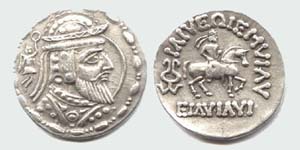
Coins of Khwarazm with images and descriptions
History of Khwarazm
Khwarezm is an oasis in Central Asia, located in the lowlands of Amu-Darya (Oxus) on lands of its ancient and modern deltas on the territory of modern Uzbekistan and partially Turkmenistan. Khwarezm is one the most ancient hotbeds of high agricultural culture.
Khwarezm was famous from great antiquity (ancient Persian Khuvarazmish, in Avesta, the sacred book of the Zoroastrian religion – Khwairezm, and Arabic – Khwarizm). The name Khwarezm is translated (from Iranian “khur” – sun, and ending “zm” – land) as the land of the sun, lowland, fertile land, land of the people Khwari. Sometimes, from the city Khiva, it was called the Khiva oasis.

Ancient Khwarezm cultural community had formed in 7th-6th centuries B.C. on the basis of the local saco-massagetian people under strong interaction of southern agricultural civilizations. In the last third of the 6th century B.C. Khwarezm was conquered by the Persians and drawn into the system of cultural ties of the Achaemenid Empire.
At the end of the 5th or in the begging of the 4th century B.C. it was apportioned into a separate satrapy, but soon, as could be judged from the ancient sources, it seized to be under the control of the Achaemenids. Khwarezm’s de-facto independence to a large degree had defined its further cultural history.
Not being part of the Hellenistic empire Khwarezm had become a distinctive preserve of ancient Eastern traditions of Central Asia. In the 2d century B.C. Khwarezm had suffered a military rout. On most monuments from that time signs of powerful fires were detected. Undoubtedly, these are the signs of stormy events related to the movement of the steppe tribes, which destroyed Graeco-Bactria and put Parthia to the edge of demise.
After the rout the Khwarezm culture had retained a part of its traditions, but it got noticeably barbarized and dimmed. However at the same time in the 2d century B.C. the Khwarezm coin production had begun, first, though, imitative, but still attesting to the later socioeconomic community. The first Kwarezm coins were large silver imitations of tetradrachms of Eukratides, distinguished from its prototype by the greater distortion of inscriptions and by the presence of a distinctive mark – tamgha on its reverse.
Later on the obverse the likeness of Eukratides is replaced by a portrait of a local ruler, and along with a distorted Greek legend a legend in the Khwarezm language is put down, conveying the name and title of the ruler. On the reverse of the coins an image of a rider starts to appear. Some researchers regard that this is the god-rider Siyavush, who, according to Biruni, was the founder of the dynasty of the Khwarezm kings, others see in him an image of a deified king.
An image of a king-rider is invariable, as is the Khwarezm tamgha, are present on all silver coins of this region for the period of seven centuries, up until the end of the Khwarezm coinage in the middle of the 7th century A.D. Only the style and some details had been modified. This unique phenomenon in the numismatics of Central Asia gives evidence to stable traditions and continuity of the Khwarezm kings, who came from the same dynasty. 4th-8th centuries were a difficult period in Khwarezmian history.
This was the time of development of feudal relationships and the formation of the early medieval culture, which, based on the name of the ruling dynasty, the name of Afrigids. The political history of Khwarezm can only be reconstructed fragmentally: written sources give good coverage only to the events of the campaigns of conquest of the beginning of the 8th century of the Arab general Quteiba b.Muslim. Not ruled out though, that between the 3d and 7th centuries, at the time when an interruption is detected in the Khwarezm coinage, the country had been subjected to the Sassanian invasion, and in the 6th-7th centuries it had been a part of the Turkic Empire.
The Arab invasion in the 8th century was destructive to the Khwarezm culture: the country was plundered, scientists were expelled, their works burned. However already at the end of the 8th century a new resurgence is detected, which leads to the flourishing of economy and culture in the 9th-10th centuries.
Coins catalog of Khwarazm
Unknown rulers
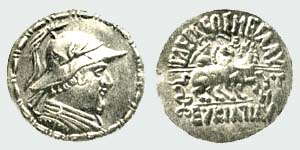
Kh1 Imitation of the tetradrachm of the Bactrian king Eucratides, late 2nd century BC. Obverse: Portrait of the king in a helmet to the right. Reverse: Distorted Greek legend PAΣIΛEΩΣ MEΓAΛY, below EYKIATIΔY.
Galloping Dioscuri.
On the right is the monogram “NT”, on the left is tamga. (#6 B. Weinberg, Coins of Ancient Khorezm, type AI, #51 M. Mitchiner, Indo-Greek and…, Type 497) Silver, D-34 mm.
Weight 15.64 grams.
/Unique/
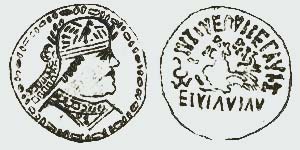
Kh2 Unknown ruler, 1st century BC. Obverse: Bust of a beardless king wearing a crown to the right. Reverse: Distorted legend: IVXIVEΩVIIEΓΛVΛEIVIΛVI.
Galloping Dioscuri.
On the right is a monogram, on the left is a tamga (different than on the previous coin). (#6 B. Weinberg, Coins of Ancient Khorezm, type AII) Silver, D-34 mm.
Weight 13.6 grams.
/Unique/

Kh3 Unknown ruler, late 1st century BC.
– beginning of the 1st century AD Obverse: Bust of a bearded king wearing a crown to the right.
Behind the head is a schematic image of Nika.
In front of the face there is a halo-type arc. Reverse: Distorted legend: IVIVEΩIEΩΓΛVE EIΛVIΛΓ.
Horseman wearing a crown and diadem.
On the left is tamga. (#6 B. Weinberg, Coins of Ancient Khorezm, type AIII) Silver /Extremely Rare/

Kh4 Unknown ruler, mid-1st century AD Obverse: Bust of a bearded king wearing a crown to the right.
Behind the head is a schematic image of Nika.
In front of the face there is a halo-type arc. Reverse: Distorted, unreadable Greek legend.
Horseman wearing a crown and diadem.
Below is a Khorezm legend with the name of the king (part of the coin with the name is broken off on both known copies).
On the left is tamga. (#6 B. Weinberg, Coins of Ancient Khorezm, type B(1)I ) Silver /Extremely Rare/
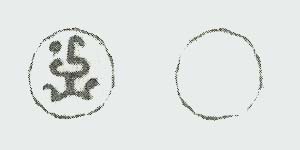
Kh5 Unknown ruler, mid-1st century AD Single-sided coin Obverse: Tamga in the center, top left dot. These coins are mostly reminted from Kushan clipped copper coins.
Perhaps this is the first attempt at copper coining in Khorezm. (#6 B. Weinberg, Coins of Ancient Khorezm, type B, B/2) Copper /Very Rare/
King Artav
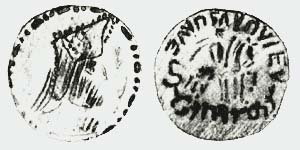
Kh6 King Artav, late 1st century AD. Obverse: Bust of a beardless king wearing a crown to the right. Reverse: Distorted, unreadable Greek legend.
Horseman wearing a crown and diadem.
Below is a Khorezm legend with the name of the king (‘rt’w MLK’ = “righteous”).
On the left is tamga. (#6 B. Weinberg, Coins of Ancient Khorezm, type B(1)II) Silver /Extremely Rare/

Kh7 King Artav, late 1st century AD. Single sided coin. Obverse: Khorezm legend (“righteous”), without title. (#6 B. Weinberg, Coins of Ancient Khorezm, type B(2)20) Copper, D-16 mm.
/Extremely Rare/
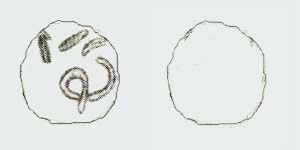
Kh8 King Artav, late 1st century AD. Single sided coin. Obverse: distorted Khorezm legend (“righteous”), without title. (#6 B. Weinberg, Coins of Ancient Khorezm, type B(2)21) Copper, D-14 mm.
/Extremely Rare/
Unknown ruler
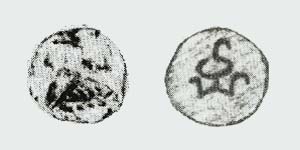
Kh9 Unknown ruler Obverse: Bust of a bearded king left wearing a diadem with a crescent. Reverse: Tamga in the center. Possible imitation of Parthian coins. (#6 B. Weinberg, Coins of Ancient Khorezm, type B, B/3) Copper /Extremely Rare/
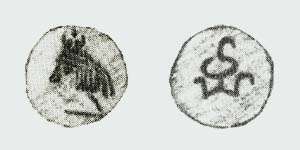
Kh9a Unknown ruler Obverse: Bust of a beardless king to the left wearing a diadem with a crescent. Reverse: Tamga in the center. Possible imitation of Parthian coins. (#6 B. Weinberg, Coins of Ancient Khorezm, type B, B/3) Copper /Extremely Rare/
King Artramush
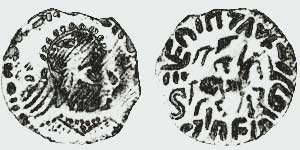
Kh10 King Artramush, late 2nd – early 3rd century AD. Obverse: Bust of a beardless king wearing a crown to the right. Reverse: Distorted, unreadable Greek legend.
A horseman wearing a crown and diadem holds a spear.
Below is a Khorezm legend with the name of the king (wrtrmws – “wearing chain mail” MLK’).
On the left is an S-shaped tamga. (#6 B. Weinberg, Coins of Ancient Khorezm, type B(1)III ) Silver /Extremely Rare/
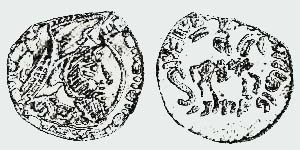
Kh11 King Artramush, late 2nd – early 3rd century AD. Obverse: Bust of a bearded king wearing a crown to the right.
Behind the head is a schematic image of Nika.
In front of the face there is a halo-type arc. Reverse: Distorted, unreadable Greek legend.
A horseman wearing a crown and diadem holds a spear.
Below is a Khorezm legend with the name of the king.
On the left is an S-shaped tamga. (#6 B. Weinberg, Coins of Ancient Khorezm, type B(1)IV) Silver /Unique/

Kh12 King Artramush (?), late 2nd – early 3rd century AD. Obverse: The king’s head to the right wearing a crown with a crescent. Reverse: S-shaped tamga in the center. At the same time, Kushan copper coins minted with this tamga were in circulation. (#6 B. Weinberg, Coins of Ancient Khorezm, type B, B/1) Copper /Extremely Rare/
King Vazamar
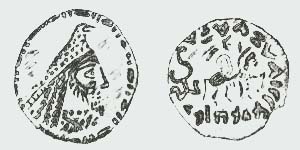
Kh13 King Vazamar, second half of the 3rd century AD. Obverse: Bust of a bearded king to the right wearing a crown in the form of an eagle. Reverse: Distorted, unreadable Greek legend.
A horseman wearing a crown and diadem holds a spear.
Below is a Khorezm legend with the name of the king (wzm’r MLK’).
On the left is tamga. (#6 B. Weinberg, Coins of Ancient Khorezm, type B(2)V ) Silver /Extremely Rare/
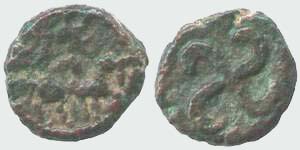
Kh14 King Vazamar, second half of the 3rd century AD. Obverse: Horseman wearing a diadem to the right. Reverse: Tamga in the form of a swastika. (#6 B. Weinberg, Coins of Ancient Khorezm, type B(2)V/1) Copper, D-13 mm.
/Very Rare/
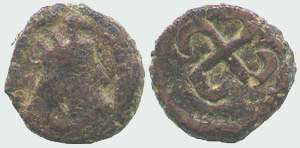
Kh15 King Vazamar, second half of the 3rd century AD. Obverse: Bust of a bearded king to the right wearing a crown in the form of a camel. Reverse: Tamga in the form of a swastika. (#6 B. Weinberg, Coins of Ancient Khorezm, type B(2)V/2) Copper, D-14 mm.
/Very Rare/
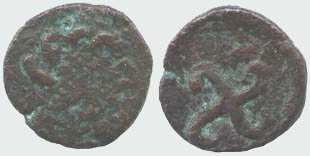
Kh16 King Vazamar, second half of the 3rd century AD. Obverse: circular Khorezm legend. Reverse: Tamga in the form of a swastika. (#6 B. Weinberg, Coins of Ancient Khorezm, type B(2)V/3) Copper, D-17 mm.
/Very Rare/
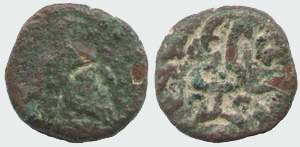
Kh17 King Vazamar, second half of the 3rd century AD. Obverse: Bust of a bearded king to the right wearing a crown in the form of an eagle. Reverse: Tamga in the center, around the Khorezm legend. (#6 B. Weinberg, Coins of Ancient Khorezm, type B(2)V/4) Copper, D-16 mm.
/Very Rare/
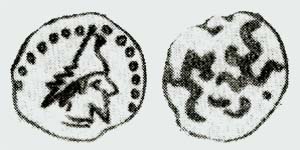
Kh18 King Vazamar, second half of the 3rd century AD. Obverse: Bust of a bearded king to the right wearing a crown in the form of an eagle. Reverse: Two tamgas surrounded by the Khorezm legend. (#6 B. Weinberg, Coins of Ancient Khorezm, type B(2)V/5) Copper, D-15 mm.
/Extremely Rare/
King Bivarsar

Kh19 King Bivarsar, first half of the 4th century AD. Obverse: Bust of a bearded king to the right wearing a diadem and crown with a crescent. Reverse: Horseman in the center.
On the left is a tamga, around a legend: part of the legend is distorted, unreadable Greek, part is Khorezm (“ten-thousand-headed”). (#6 B. Weinberg, Coins of Ancient Khorezm, type B(2)VI) Silver.
/Extremely Rare/
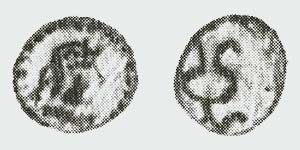
Kh20 King Bivarsar, first half of the 4th century AD. Obverse: Bust of a bearded king facing right wearing a crown with a crescent. Reverse: Tamga in the center. (#6 B. Weinberg, Coins of Ancient Khorezm, type B(2)VI/6) Copper, D-12 mm.
/Extremely Rare/
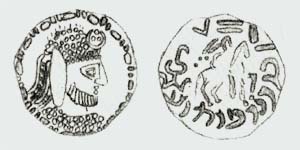
Kh21 King Bivarsar, first half of the 4th century AD. Obverse: Bust of a bearded king to the right wearing a diadem and crown with a crescent. Reverse: Horseman in the center.
On the left is a tamga (different than on the previous coin), around a legend: part of the legend is distorted, unreadable Greek, part is Khorezm with an additional sign in the name of the king. (#6 B. Weinberg, Coins of Ancient Khorezm, type B(2)VII) Silver.
/Extremely Rare/
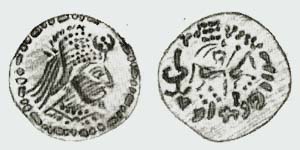
Kh22 King Bivarsar, first half of the 4th century AD. Like Kh16;
different options for crown and clothing. Silver.
/Extremely Rare/
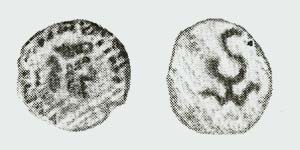
Kh23 King Bivarsar, first half of the 4th century AD. Obverse: Bust of a bearded king facing right wearing a crown with a crescent. Reverse: Tamga in the center. (#6 B. Weinberg, Coins of Ancient Khorezm, type B(2)VII/7) Copper, D-13 mm.
/Very Rare/
Unknown ruler
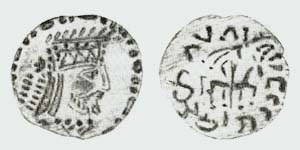
Kh24 Unknown ruler, 4th century AD Obverse: Bust of a bearded king to the right wearing a crown. Reverse: Horseman in the center.
On the left is a tamga, around a legend: part of the legend is distorted, unreadable Greek, part is Khorezmian. (#6 B. Weinberg, Coins of Ancient Khorezm, type B(2)VIII) Silver.
/Extremely Rare/
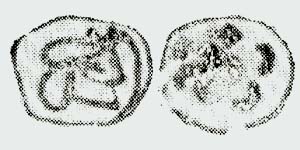
Kh26 Unknown ruler, 4th century AD
(?) Obverse: Bust of a bearded king facing right wearing a crown with a crescent. Reverse: Tamga-swastika surrounded by the Khorezm legend. (#6 B. Weinberg, Coins of Ancient Khorezm, type B(2)9 ) Copper, D-12 mm.
/Extremely Rare/

Kh27 Unknown ruler, 4th century AD
(?) Obverse: Head of a bearded king to the right wearing a crown in the form of a lying camel. Reverse: Tamga in the center. (#6 B. Weinberg, Coins of Ancient Khorezm, type B(2)10) Copper, D-12 mm.
/Very Rare/
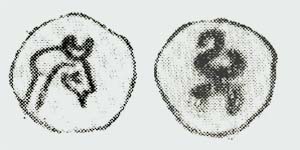
Kh28 Unknown ruler, 4th century AD
(?) Obverse: Head of a beardless king to the right wearing a crown with a crescent. Reverse: Tamga in the center. (#6 B. Weinberg, Coins of Ancient Khorezm, type B(2)11) Copper, D-12 mm.
/Very rare/
King Sanbar

Kh29 King Sanbar, 5th century AD
(?) Obverse: Head of a bearded king to the right wearing a diadem or crown with a crescent. Reverse: A dot surrounded by the Khorezm legend (“repelling the enemy”). (#6 B. Weinberg, Coins of Ancient Khorezm, type B(2)12) Copper, D-12 mm.
/Extremely rare/
King Rast
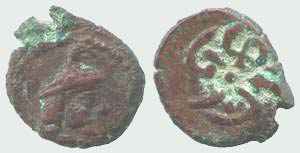
Kh30 King Rast, 5th century AD
(?) Obverse: Head of a bearded king to the right wearing a crown in the form of an eagle. Reverse: In the center there is a dot, in a circle there is the Khorezm legend (“always ready”). (#6 B. Weinberg, Coins of Ancient Khorezm, type B(2)13) Copper, D-15 mm.
/Very Rare/
King Siyavsparsh
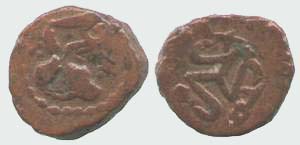
Kh31 King Siyavsparsh, 5th century AD.
(?) Obverse: Head of a beardless king to the right wearing a crown. Reverse: Tamga surrounded by the Khorezm legend (“[possessing] black stallions”). (#6 B. Weinberg, Coins of Ancient Khorezm, type B(2)14) Copper, D-12 mm.
/Extremely rare/
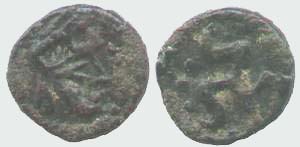
Kh32 King Siyavsparsh, 5th century AD.
(?) Obverse: Head of a beardless king to the right wearing a crown, more schematized. Reverse: Tamga in the center. (#6 B. Weinberg, Coins of Ancient Khorezm, type B(2)15) Copper, D-11 mm.
/Very rare/
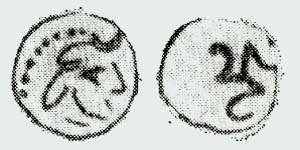
Kh33 King Siyavsparsh, 5th century AD.
(?) Obverse: Head of a beardless king to the right wearing a diadem or crown with a crescent. Reverse: Tamga in the center. (#6 B. Weinberg, Coins of Ancient Khorezm, type B(2)16) Copper, D-12 mm.
/Very rare/
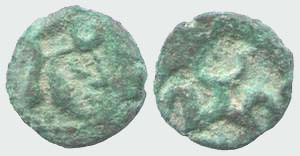
Kh34 King Siyavsparsh, 5th century AD.
(?) Obverse: Head of a beardless king to the right wearing a diadem or crown with a crescent. Reverse: Tamga in the center. (#6 B. Weinberg, Coins of Ancient Khorezm, type B(2)17) Copper, D-11 mm.
/Very rare/
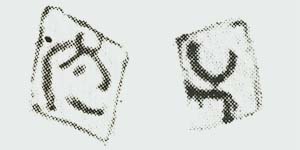
Kh35 King Siyavsparsh (?), 5th century AD.
(?) Obverse: The king’s head to the right wearing a diadem or crown with a crescent (very schematized image). Reverse: Tamga in the center. (#6 B. Weinberg, Coins of Ancient Khorezm, type B(2)18) Copper, D – 9-10 mm.
/Very rare/
Ruler Vir

Kh36 Ruler Vir, 5th century AD Obverse: Head of a beardless king to the right wearing a crown with a crescent. Reverse: One-word Khorezm legend:( wir “husband”), without title. (#6 B. Weinberg, Coins of Ancient Khorezm, type B(2)19) Copper, D-10 mm.
/Very Rare/
King Tutukhas
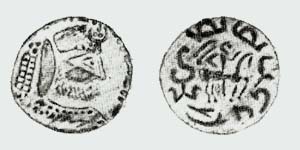
Kh37 King Tutukhas, late 5th – early 6th century AD. Obverse: Bust of a bearded king to the right wearing a crown with a crescent and a diadem. Reverse: Horseman in the center.
On the left is the tamga, around the Khorezm legend. (#6 B. Weinberg, Coins of Ancient Khorezm, type VI) Silver.
/Extremely Rare/
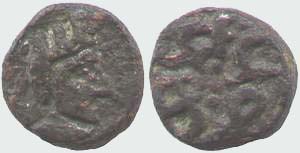
Kh38 King Tutukhas, late 5th – early 6th century AD. Obverse: Bust of the king to the right wearing a crown in the form of a lying camel. Reverse: In the center there are 5 dots, around the Khorezm legend. (#6 B. Weinberg, Coins of Ancient Khorezm, type VI/1) Copper /Extremely Rare/
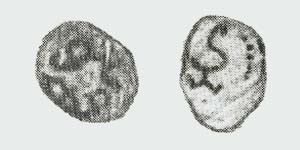
Kh39 King Tutukhas, late 5th – early 6th century AD. Obverse: In the center there are 5 dots, around the Khorezm legend. Reverse: Tamga in the center. (#6 B. Weinberg, Coins of Ancient Khorezm, type VI/2) Copper /Extremely Rare/
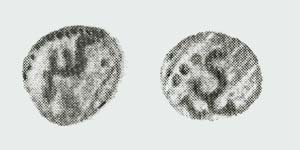
Kh40 King Tutukhas, late 5th – early 6th century AD. Obverse: Bust of the king to the right wearing a crown in the form of a lying camel. Reverse: Tamga in the center. (#6 B. Weinberg, Coins of Ancient Khorezm, type VI/3) Copper /Extremely Rare/
Unknown ruler
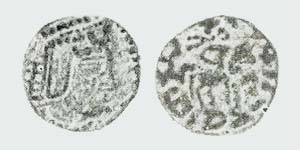
Kh42 Unknown ruler, 6th century AD Obverse: Bust of a beardless king facing right wearing a crown with a crescent. Reverse: Horseman in the center.
On the left is the tamga, around the Khorezm legend. (#6 B. Weinberg, Coins of Ancient Khorezm, type GI) Silver.
/Extremely Rare/
King Bravik

Kh43 King Bravik, late 6th – early 7th century AD. Obverse: Head of a beardless king wearing a crown to the right. Reverse: Horseman in the center.
On the left is the tamga, around is the Khorezm legend. (#6 B. Weinberg, Coins of Ancient Khorezm, type GII) Silver /Extremely Rare/
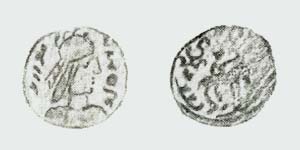
Kh44 King Bravik, late 6th – early 7th century AD. Obverse: Head of a beardless king wearing a crown to the right.
In front of the face the title, behind the head the name: Brwyk. Reverse: Horseman in the center.
On the left is a tamga, around is a Khorezm legend. (#6 B. Weinberg, Coins of Ancient Khorezm, type GII/1) Copper, D-20 mm.
/Very Rare/
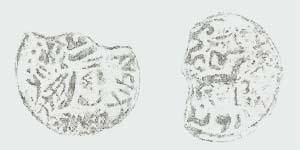
Kh44a King Bravik, late 6th – early 7th century AD. Obverse: Head of a beardless king wearing a crown to the right.
In front of the face the title, behind the head the name:Brwyk. Reverse: Horseman in the center.
On the left is a tamga, around is a Khorezm legend. (#6 B. Weinberg, Coins of Ancient Khorezm, type GII/2) Copper, D-25 mm.
/Extremely Rare/
King Scar
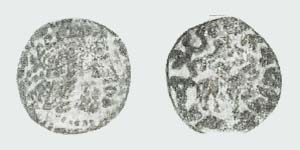
Kh45 King Scar, 7th century AD Obverse: Head of a beardless king wearing a crown to the right. Reverse: Horseman in the center.
On the left is the tamga, around is the Khorezm legend. (#6 B. Weinberg, Coins of Ancient Khorezm, type GIII) Silver, D-26 mm.
/Extremely Rare/
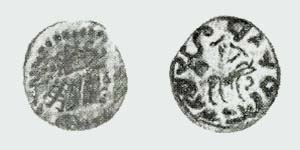
Kh46 King Scar, 7th century AD Obverse: Head of a beardless king wearing a crown to the right. Reverse: Horseman in the center.
On the left is the tamga, around is the Khorezm legend. (#6 B. Weinberg, Coins of Ancient Khorezm, type GIII/3) Copper, D-22 mm.
/Very Rare/
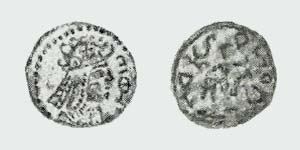
Kh47 King Scar, 7th century AD Obverse: Head of a beardless king wearing a crown to the right.
In the face of the title. Reverse: Horseman in the center.
On the left is the tamga, around is the Khorezm legend. (#6 B. Weinberg, Coins of Ancient Khorezm, type GIII/4) Copper, D-20 mm.
/Very Rare/
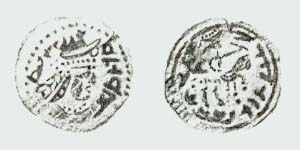
Kh48 King Scar, 7th century AD Obverse: Head of a beardless king wearing a crown to the right.
In front of the face is the title, behind the head is the name. Reverse: Horseman in the center.
On the left is the tamga, around is the Khorezm legend. (#6 B. Weinberg, Coins of Ancient Khorezm, type GIII/5) Copper, D-26 mm.
/Very Rare/
King Azkatsvar I
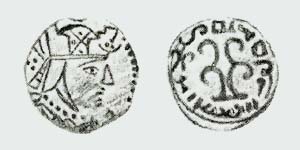
Kh49 King Azkatsvar I, early 8th century AD.
(died in 712 AD) Obverse: Head of a beardless king wearing a crown to the right. Reverse: Tamga in the center.
On the left is the tamga, around is the Khorezm legend. (#6 B. Weinberg, Coins of Ancient Khorezm, type G11a) Copper, D-22 mm.
/Very Rare/
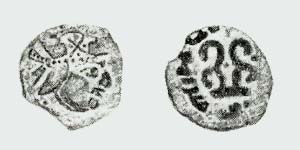
Kh49a King Azkatsvar I, early 8th century AD.
(died in 712 AD) Obverse: Head of a beardless king wearing a crown to the right. Reverse: Tamga in the center, around the Khorezm legend. (#6 B. Weinberg, Coins of Ancient Khorezm, type G11b) Copper, D-19 mm.
/Very Rare/
Kerder, ruler Khosro
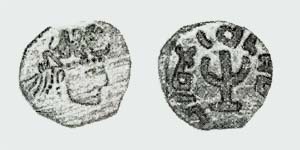
Kh50 Kerder region, appanage ruler Khosro, early 8th century AD. Obverse: Head of a beardless king wearing a crown to the right. Reverse: Tamga in the center, around the Khorezm legend. (#6 B. Weinberg, Coins of Ancient Khorezm, type G12) Copper, D-23 mm.
/Very Rare/
Unknown ruler
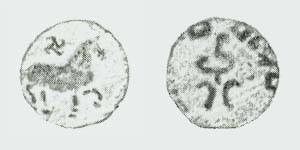
Kh51 Unknown ruler, early 8th century AD. Obverse: Horse to the right.
At the top there is a sign in the form of a swastika. Reverse: Tamga in the center, around the Khorezm legend. (#6 B. Weinberg, Coins of Ancient Khorezm, type G14) Copper, D-19 mm.
/Extremely Rare/
King Kanik

Kh52 King Kanik, early 8th century AD. Obverse: Bust of the beardless king to the right. Reverse: Horseman in the center.
On the left is the tamga, around the Khorezm legend. (#6 B. Weinberg, Coins of Ancient Khorezm, type GIV) Silver.
D-26 mm.
/Extremely Rare/
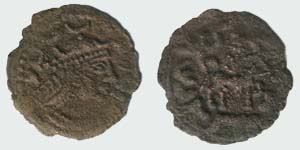
Kh53 King Kanik, early 8th century AD. Obverse: Bust of a beardless king facing right wearing a crown with a crescent.
In front of the face the title, behind the head the name k’nyk. Reverse: Horseman in the center.
On the left is a tamga, around is a Khorezm legend. (#6 B. Weinberg, Coins of Ancient Khorezm, type GIV/7) Copper, D-24 mm.
/Very Rare/
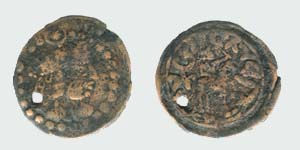
Kh54 King Kanik, early 8th century AD. Obverse: Bust of a beardless king facing right wearing a crown with a crescent. Reverse: Horseman in the center.
On the left is the tamga, around the Khorezm legend. (#6 B. Weinberg, Coins of Ancient Khorezm, type GIV/8) Copper, D-29 mm.
/Very Rare/
King Savshaphan
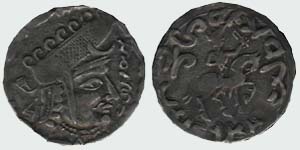
Kh55 King Savshaphan, mid-8th century AD. Obverse: Bust of the beardless king to the right wearing a crown and diadem.
In the face of the king, a Sogdian legend with his name. Reverse: Horseman in the center.
On the left is a tamga, around is a Khorezm legend ( “[possessing] the glory of Siyavush”). (#6 B. Weinberg, Coins of Ancient Khorezm, type GV) Silver.
D-24 mm.
/Very Rare/
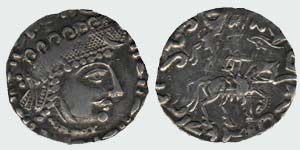
Kh55a King Savshaphan, mid-8th century AD. Obverse: Bust of the beardless king to the right wearing a crown and diadem. Reverse: Horseman in the center.
On the left is a tamga, around is a Khorezm legend (“[possessing] the glory of Siyavush”). Silver.
D-24 mm.
/Extremely Rare/
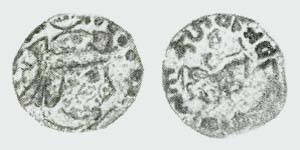
Kh56 King Savshaphan, mid-8th century AD. Obverse: Bust of a beardless king facing right wearing a crown with a crescent. Reverse: Horseman in the center.
On the left is the tamga, around the Khorezm legend. (#6 B. Weinberg, Coins of Ancient Khorezm, type GV/9) Copper, D-23 mm.
/Very Rare/
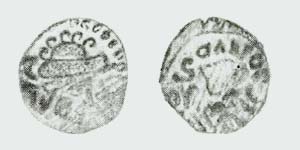
Kh57 King Savshaphan, mid-8th century AD. Obverse: Head of a beardless king to the right wearing a crown and diadem. Reverse: Horseman in the center.
On the left is the tamga, around the Khorezm legend. (#6 B. Weinberg, Coins of Ancient Khorezm, type GV/10) Copper, D-21 mm.
/Rare/
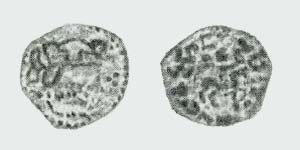
Kh58 King Savshaphan, mid-8th century AD.
(possibly a specific coinage of Kerder after the uprising suppressed by the Arabs in 728) Obverse: Head of a beardless king to the right wearing a crown.
There are three dots in front of the face. Reverse: Horseman in the center.
On the left is the tamga, around the Khorezm legend. (#6 B. Weinberg, Coins of Ancient Khorezm, type GV/13) Copper, D-20 mm.
/Rare/
King Azkatsvar II
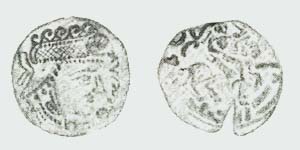
Kh59 King Azkatsvar II, late 8th century AD. Obverse: Bust of a beardless king wearing a crown to the right.
In the face of the Sogdian legend, the name of the king. Reverse: Horseman in the center.
On the left is the tamga, around the Khorezm legend. This king was the first to adopt Islam and the Islamic name Abdallah in Khorezm. (#6 B. Weinberg, Coins of Ancient Khorezm, type GVIa) Silver, D-23 mm.
/Extremely Rare/
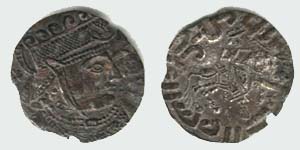
Kh60 King Azkatsvar II, late 8th century AD. Obverse: Bust of a beardless king wearing a crown to the right.
In the face of the Sogdian legend, the name of the king. Reverse: Horseman in the center.
On the left is the tamga, around the Khorezm legend.
On the left above the horse is an Arabic inscription. (#6 B. Weinberg, Coins of Ancient Khorezm, type GVIb) Silver, D-22 mm.
/Extremely Rare/
Unknown ruler
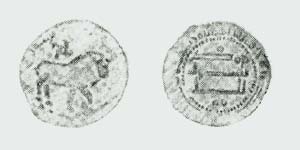
Kh61 Unknown ruler, late 8th century AD. Obverse: Horse to the right.
At the top there is a sign in the form of a swastika. Reverse: Similar to the Abbasid coinage with the symbol of faith in the center and a circular legend (illegible). (#6 B. Weinberg, Coins of Ancient Khorezm, type G15) Copper, D-20 mm.
/Extremely rare/
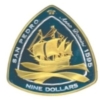




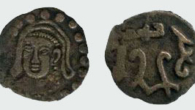
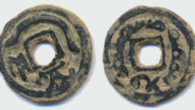
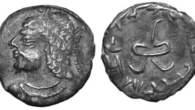
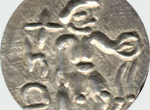
Leave a Reply